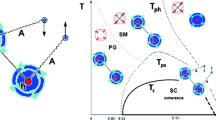Abstract.
Recent STM measurements have revealed the existence of periodic charge modulations at the surface of certain cuprate superconductors. Here we show that the observed patterns are compatible with the formation of a three-dimensional crystal of doped holes, with space correlations extending between different Cu-O layers. This puts severe constraints on the dynamical stability of the crystallised hole structure, resulting in a close relationship between the periodicity of the electronic modulation and the interlayer distance.
Similar content being viewed by others
References
C. Howald, H. Eisaki, N. Kaneko, A. Kapitulnik, cond-mat/0201546 (unpublished)
J. E. Hoffman et al. , Science 295, 466 (2002)
J.E. Hoffman, et al. , Science 297, 1148 (2002)
C. Howald, H. Eisaki, N. Kaneko, M. Greven, A. Kapitulnik, Phys. Rev. B 67, 014533 (2003)
K. McElroy, et al. Nature 422, 592 (2003)
M. Vershinin, S. Misra, S. Ono, Y. Abe, Y. Ando, A. Yazdani, Science 303, 1995 (2004)
K. McElroy et al. , cond-mat/0404005
A. Fang, C. Howald, N. Kaneko, M. Greven, A. Kapitulnik, cond-mat/0404452
T. Hanaguri, et al. , Nature 430, 1001 (2004)
E. Wigner, Phys. Rev. 46, 1002 (1934)
A.A. Remova, B.Ya. Shapiro, Physica C 160, 202 (1989)
P. Quémerais, Mod. Phys. Lett. B 9, 1665 (1995)
S. Fratini, P. Quémerais, Mod. Phys. Lett. B 12, 1003 (1998); P. Quémerais, S. Fratini, Phys. C, 341-348, 229 (2000)
Y.H. Kim, P.H. Hor, Mod. Phys. Lett. B 15, 497 (2001)
H.C. Fu, J.C. Davis, D.-H. Lee, cond-mat/0403001
H.D. Chen, et al. , Phys. Rev. Lett. 89, 137004 (2002); H.D. Chen, et al. , Phys. Rev. B 70, 024516 (2004); H.D. Chen, et al. , Phys. Rev. Lett. 93, 187002 (2004)
M. Vojta, Phys. Rev. B 66, 104505 (2002)
Z. Tesanovic, Phys. Rev. Lett. 93, 217004 (2004)
P.W. Anderson, cond-mat/0406038
A. Bagchi, Phys. Rev. 178, 707 (1969)
For \(\gamma> 1.07\), the body centered orthorombic structure, with rectangular, stripe-like, symmetry in the planes, has a lower energy than the BCT However, taking the parameters appropriate for Na-CCOC, we find \(\Delta E <1\) meV in the concentration range x=0.02−0.06
A. Zibold et al. , Phys. Rev. B 53, 11734 (1996)
N.N. Kovaleva et al. , Phys. Rev. B 69, 054511 (2004)
K. F. Herzfeld, Phys. Rev 29, 701 (1927)
S. Fratini, P. Quémerais, Eur. Phys. J. B 29, 41 (2002)
S. Lupi, P. Maselli, M. Capizzi, P. Calvani, P. Giura, P. Roy, Phys. Rev. Lett. 83, 4852 (1999)
A. Lucarelli et al. , Phys. Rev. Lett. 90, 037002 (2003)
Assuming for simplicity that the Lorentz local field factor of the crystallised structure at the concentrations of interest does not deviate significantly from the isotropic case, we can write the following approximate expression for the critical concentration: \( x_c=\frac{3 \epsilon_\infty}{16 \pi(1-\eta)}\left(\frac{\hbar \omega_0}{Ryd}\right)^2 \frac{da_0^2}{a_B^3} \) where a B is the Bohr radius and Ryd=13.6 eV. Taking \(\epsilon_\infty\approx 4.5\) and \(\eta\approx 0.5\) eV yields \(\omega_0\approx 0.16\) which gives \(x_c=3.9\times 10^{-3} (d/a_B)\) 0.05-0.11 for several cuprate crystal structures, with corresponding modulations \(x_c\approx\) 3.5-6
Although they certainly favor charge ordering, commensurability effects decrease drastically when moving away from simple fractional fillings, and it has been shown that they do not dominate the Wigner crystal stability at low concentrations [see e.g. Y. Noda, M. Imada, Phys. Rev. Lett. 89, 176803 (2002); H. Falakshahi et al. , Eur. Phys. J. B 39, 93 (2004)]
M.A. Kastner, R.J. Birgeneau, G. Shirane, Y. Endoh, Rev. Mod. Phys. 70, 897 (1998)
H. Fröhlich, Adv. Phys. 3, 325 (1954)
S. Fratini, P. Quémerais, Eur. Phys. J. B 14, 99 (2000)
G. Rastelli, S. Ciuchi, cond-mat/0406079
Author information
Authors and Affiliations
Corresponding author
Additional information
Received: 14 June 2004, Published online: 23 December 2004
PACS:
74.72.-h Cuprate superconductors (high-T c and insulating parent compounds) - 71.30. + h Metal-insulator transitions and other electronic transitions - 71.38.-k Polarons and electron-phonon interactions
Rights and permissions
About this article
Cite this article
Rastelli, G., Fratini, S. & Quémerais, P. On the stability of hole crystals in layered cuprates. Eur. Phys. J. B 42, 305–308 (2004). https://doi.org/10.1140/epjb/e2004-00385-4
Issue Date:
DOI: https://doi.org/10.1140/epjb/e2004-00385-4




